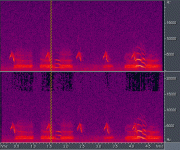I've been loaned one of these to play with for the weekend, and have a few questions.
- What's the thread size on the tripod mount? I can't get a normal camera tripod screw very far into it. Possibly it's just tight, or cross threaded.
- What settings would normally be used for recording birds? Lo cut on or off? Auto level on or off?
- If auto level is on, should the recording level control do anything?
- Unfortunately it's very windy today, so I can barely hear a thing other than the wind in the recordings. What do you normally do about that?
- It seems to start the file numbering from 001 again each time I empty the memory out. Can I make it remember the highest number used, like on a camera?
- If I press the Mark button during a wav recording, it's supposed to make an index mark. Can I access that mark with something like Audacity?
- It takes a few seconds to turn it on. Should I normally just leave it on all the time?
- It doesn't appear to have what I believe is called preroll buffer. The only way I can see around that is to also have it recording all the time. Is that what most people do?
- I can't add an index mark after the recording is done. Can the higher end models like H2 and H4 do that?
- I can't tell what the name of the current file is during recording. Can the higher end ones do that?
That's all I can think of for now.
- What's the thread size on the tripod mount? I can't get a normal camera tripod screw very far into it. Possibly it's just tight, or cross threaded.
- What settings would normally be used for recording birds? Lo cut on or off? Auto level on or off?
- If auto level is on, should the recording level control do anything?
- Unfortunately it's very windy today, so I can barely hear a thing other than the wind in the recordings. What do you normally do about that?
- It seems to start the file numbering from 001 again each time I empty the memory out. Can I make it remember the highest number used, like on a camera?
- If I press the Mark button during a wav recording, it's supposed to make an index mark. Can I access that mark with something like Audacity?
- It takes a few seconds to turn it on. Should I normally just leave it on all the time?
- It doesn't appear to have what I believe is called preroll buffer. The only way I can see around that is to also have it recording all the time. Is that what most people do?
- I can't add an index mark after the recording is done. Can the higher end models like H2 and H4 do that?
- I can't tell what the name of the current file is during recording. Can the higher end ones do that?
That's all I can think of for now.






